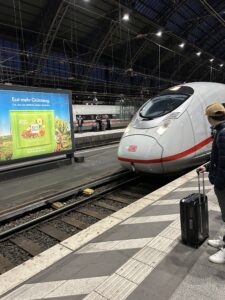International Travel: An ICE-y Experience
On Friday, January 24th, my friends and I left Bonn to see Salzburg and Munich over the weekend. It was really cool, as we hiked up a mountain, toured a salt mine, and got to explore the wonderful cities we visited. To be able to do all of these things in only three days, we needed high speed rail. Thankfully, Germany and most of Europe has an extensive rail network, which enables high speed rail to be possible. This also allows for easy transport from large cities to smaller towns.

We were supposed to leave from Bonn at 1:30, get to Cologne and get on a high speed train 40 minutes later. Our train was 30 minutes late, so we were scrambling to get on our next train. Our next train was an Inter-City Express, or an ICE. These trains can travel upwards of 300 km/h and are one of the fastest ways to travel. We spent about 6 hours on that train and the employees would occasionally check tickets to make sure that people had paid to be on the train.
High speed rail is very big in Europe, especially Germany. According to the DB website, the Deutsche Bahn has connections to over 300 stations across Germany with all trains running at least once every other hour. The first ICEs were rolled out in the 1990s and many of them still run today. DB has made more modern ICEs in the following years and they have also retrofitted some of the older models to include modern day comforts and become overall more efficient. With all of this infrastructure in place, traveling to different major cities is very fast thanks to DB’s extensive rail infrastructure. The map below from the website shows how truly extensive their rail network is.

Traveling for such a long time can also be quite stressful. Luckily has done a lot to reduce stress on their ICEs. They have overhead luggage storage as well as shelves for larger items to ensure that luggage is not lost. They have a dining car and restrooms which are very nice for longer voyages. There are also tables and outlets at each seat which can allow people to be productive while they are on their journey. Despite all of DB’s best efforts, not all stress can be avoided. Our train was running a few minutes behind and we did not have too much time to spare for our connection. Thankfully we ended up with plenty of time to transfer and the rest of our travel went smoothly.
Another nice thing about the high-speed rail infrastructure is how easy it is to travel with Eurail Passes. There are multiple different passes for domestic and international travel allowing customers to purchase the one that best suits their needs. There are options that allow give you a certain amount of “travel days” per month, allowing for unlimited trains and transfers in that given day. There are also unlimited passes that have no restriction on “travel days” for the given pass. Not all trains are included in Eurail passes, but most things are very accessible with the pass.
I think the ICEs are really nice, especially for longer distance travel, but they still have their downsides. They are great for moving from major city to major city, but trams and other trains are better for more local travels. I have noticed that they seem to be more prone to delays than the regional trains and trams. Overall I think these complaints are very minor and the transportation infrastructure is great regardless of delays.
– Owen B.
Sources:
Eurail Ticket: the train ticket for Europe | Deutsche Bahn. (n.d.). https://int.bahn.de/en/offers/eurail
Deutsche Bahn long-distance route maps. (n.d.). https://int.bahn.de/en/trains/long-distance-trains/route-maps
